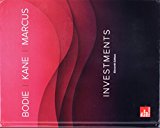
A
To select: Purchasing of bond either ‘Aaa’ or ‘Aa’ for one year investment horizon according to the excepted return value.
Introduction : Selection of the bond is decided by the incremental return value. Higher the value of return will be chosen by the investor. Return value means returns or payment after the maturity period of the bond.
B
To explain: The variables which can cause realized incremental returns to differ from the indicated initial spread relationships.
Introduction: The value of incremental return is affected by the variables like quality credit, maturity period of the bond, and spread of bond. Quality credit defines as the type of the credit and maturity period is time period of the bond.
Want to see the full answer?
Check out a sample textbook solution
Chapter 16 Solutions
Investments, 11th Edition (exclude Access Card)
- Bobby Nelson, made deposits of $880 at the end of each year for 6 years. Interest is 6% compounded annually. What is the value of Bobby’s annuity at the end of 6 years?arrow_forward1. Find the future value if $1,250 is invested in Simple interest account paying 6.5%: a. for 5 years b. for 20 years 2. Find the future amount $ 35,000 is invested for 30 years at 4.25% compounded: a. annually b. Quarterly c. monthly d. weekly 3. How much should be put into an account today that pays 7.75% compounded monthly if you need $10,000 in 5 years. 4. Find the effective rate for: a. 5.75% compounded quarterly b. 6.25% compounded daily. 5. $50 is invested at the end of each month into an account paying 7.5% compounded monthly. How much will be in the account after 5 years?…arrow_forwardSolve step by step no aiarrow_forward
 EBK CONTEMPORARY FINANCIAL MANAGEMENTFinanceISBN:9781337514835Author:MOYERPublisher:CENGAGE LEARNING - CONSIGNMENT
EBK CONTEMPORARY FINANCIAL MANAGEMENTFinanceISBN:9781337514835Author:MOYERPublisher:CENGAGE LEARNING - CONSIGNMENT
